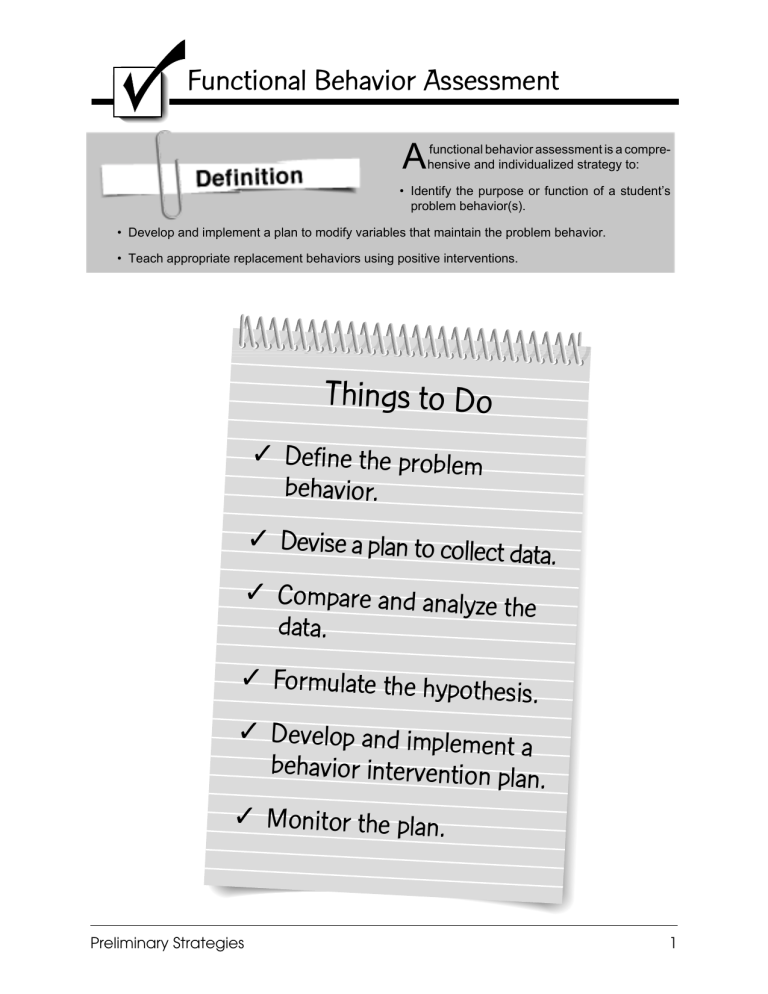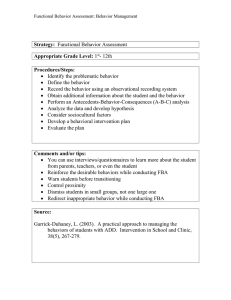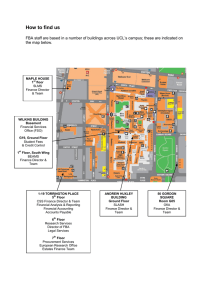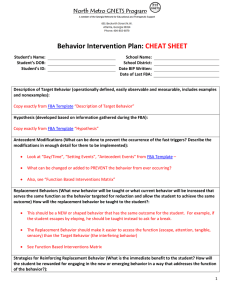
LRBI Checklist Functional Behavior Assessment Functional Behavior Assessment A functional behavior assessment is a comprehensive and individualized strategy to: • Identify the purpose or function of a student’s problem behavior(s). • Develop and implement a plan to modify variables that maintain the problem behavior. • Teach appropriate replacement behaviors using positive interventions. Things to Do ✓ Define the problem behavior. ✓ Devise a plan to collect d ata. ✓ Compare and analyze th e data. ✓ Formulate the hypothesi s. ✓ Develop and implemen ta behavior intervention plan. ✓ Monitor the plan. Preliminary Strategies 1 LRBI Checklist Functional Behavior Assessment Define Define the the problem problem behavior. behavior. A well-defined behavior is essential when collecting data and communicating results with other team members. Define the behavior in specific, observable, and measurable terms. In other words, something you can see and count. Observable & Measurable • • • • For instance, this is too vague . . . Portia is aggressive. Instead . . . Portia pokes, hits, or kicks other students with her feet or hands during transition time. Easily observed Countable Beginning/end Repeatable . . . is a behavior that you can see and measure. Devise Devise aa plan plan to to collect collect data. data. There are two basic methods for collecting data—direct and indirect. Indirect methods often use student records, interviews, questionnaires, or checklists to identify how others perceive the situation and possible motivations for the problem behavior. Stud e Reco n t rds Then more direct methods, such as observations, record the situational factors surrounding the problem behavior. Indirect Method Begin by reviewing the student’s records. In a systematic fashion, identify any previous relevant background data from existing documents that relate to the problem behavior. Inter view s Que stion naire s Che cklis ts Com p P ro g uter ram s Preliminary Strategies 2 LRBI Checklist Functional Behavior Assessment When conducting an interview, consider asking the following questions: . . . is present when the problem occurs? WHO WHAT . . . is happening just before the problem occurs, and what happens immediately after the problem behavior? . . . does the problem behavior occur? WHEN . . . does the problem behavior take place? WHERE And finally, are there times or places when the problem behavior does NOT occur? Such information is valuable when planning future interventions. When using indirect methods, watch for factors that can influence a student’s behavior, such as: Preliminary Strategies ✍ ✍ ✍ Physiological ✍ Setting events or incidents that happen sometime before the problem situation. Environmental Curricular and instructional Phys iolog Envir onm enta ical l Curr ic Instru ular & ction al Settin g Even ts 3 LRBI Checklist Functional Behavior Assessment Using a variety of indirect methods like these are especially important if there’s more than one reason for the student’s noncompliant behavior. To know if you’re on the right track, gather information from as many sources and places as possible, such as daily classes, counselors and teachers, and after-school activities. Direct Method Next use direct assessment to observe and record the problem events as they happen. Direct assessments may include frequency counts, interval recording systems, and antecedent-behavior-consequence—or A-B-C charts. Freq uen Cou cy nts To use an A-B-C form, Inter start by writing the Reco val rding basic information, such as the student’s name, observer’s name, and so on. Then each time A-BC Ch the student behaves arts inappropriately, record the behavior and what events occur just before. These events are called “antecedents.” Also be sure to record the consequences—or what happens right after the incident. Remember to record only those things you see or hear, not your interpretation of the behavior. Continue collecting data in this manner until a pattern emerges that shows a relationship between the student’s behavior and his environment. Typically this requires 2 to 5 days, depending on how often the behavior occurs and the frequency of the observation. The more data you collect, the more accurate the picture of the student’s dayto-day behavior and the events that surround it. Preliminary Strategies 4 LRBI Checklist Functional Behavior Assessment Compare Compare and and analyze analyze the the data. data. To see the big picture, summarize the data. A summary could identify: ✍ ✍ Setting events. ✍ ✍ The target behavior. setting events RY FBA SUMMA target behaviors antecedents consequences Antecedents or triggering events. Consequences that maintain the behavior. Another summary could simply identify who, what, when, and where. FBA SUMMA RY Student: ____ ____________ ______ Date : ____________ ___________ ______ Prob lem Behavior ____________ : _________ ____________ __ Definition: __ ____________ ____________ WHO ____________ WHAT WHEN _ WHERE Organizing your data in these ways will help clarify relationships between the student’s behavior and related events or factors. Formulate Formulate the the hypothesis. hypothesis. Based on the data you collect, give your best, educated guess to explain the function or reason for the behavior. Generally speaking, problem behaviors serve two basic functions: ✍ ✍ To get something. To avoid and escape something. Develop Develop and and implement implement aa behavior behavior intervention intervention plan. plan. Students respond best to Behavior Intervention Plans (BIP) that use positive methods to encourage and teach appropriate, alternative behaviors. For example, positive methods may include: ✍ ✍ ✍ ✍ Modifying the physical environment. Adjusting the curriculum or instructional strategy. Changing the antecedents or consequences for the student’s behavior. Finally, teaching a more acceptable replacement behavior that serves the same function. Preliminary Strategies 5 LRBI Checklist Functional Behavior Assessment An effective BIP should teach problem-solving skills the student can use on a regular basis. It also allows an instructor to explore additional strategies NOT generally considered. Monitor Monitor the the plan. plan. Collect Data Regardless of the behavior intervention plan that your team develops, be sure to regularly monitor the student’s progress over time. Continue or Modify This means: ✍ ✍ Review and Evaluate Collect data on student progress. Review and evaluate the behavior goals. ✍ Then determine whether to continue or modify the BIP. Setting review dates ensures that this will happen. A FBA is not a one-shot process. You can do an FBA anytime you need useful information to design effective interventions, because conducting an FBA is not only complying with federal law, it’s Preliminary Strategies 6 LRBI Checklist Functional Behavior Assessment Examples Examples basic good practice. move. Example 1 Example 2 Merlinda is a preschool student who likes her teacher’s attention. When Merlinda is getting ready for sharing time, she often pokes or kicks other students. Her instructor responds by putting Merlinda on her lap. But over time, the instructor notices that Merlinda’s behavior is increasing rather than going away. To solve this problem, the instructor may do any of the following: Silvia, a 14-year-old student with severe disabilities, often refuses to let go of her favorite objects when participating in activities. This behavior particularly interferes with her ability to work. To solve this problem, her work instructor may: ✍ ✍ ✍ Stop putting Merlinda on the instructor’s lap when Merlinda misbehaves. Modify the work activities by giving Silvia one-third of the usual number of items to sort. ✍ Give Merlinda lots of attention when she keeps her hands and feet to herself. Praise Silvia when she puts her favorite objects down to work. ✍ Give Silvia time away from the task with her favorite objects if she works faster. ✍ As a replacement behavior, teach Silvia ✍ Mark seating spaces for all the children. ✍ Teach Merlinda to politely ask others to Variations Variations of of the the Technique Technique to raise her hand and ask for a break from the activity. Computer programs offer another indirect method to analyze problem behaviors. For example, the Functional Assessment and Intervention Program Potential Potential Problems Problems and and Solutions Solutions (FAIP) asks a series of questions relating to the student’s noncompliant behavior; then analyzes the data to recommend interventions. Consider using different methods of collecting data. Do you need to spend more time observing the problem-behaving student? Have you considered events outside of the regular classroom? REMEMBER: The more data you collect, the more accurate the picture of the student’s Preliminary Strategies 7 LRBI Checklist Functional Behavior Assessment behavior problem and possible contributing factors. Continue collecting and evaluating data. Use the data to determine whether to continue or modify the BIP. REMEMBER: Use positive interventions that: ✍ ✍ Modify the physical environment. ✍ Change the antecedents or consequences for the student’s behavior. ✍ Teach a more acceptable replacement behavior that serves the same function. Getting Getting Ready Ready Determine WHO should participate in the assessment? With proper training, experience, and support, much of an FBA can be done by: ✍ ✍ Special education instructors Paraeducators Adjust the curriculum or instructional strategy. ✍ ✍ ✍ ✍ Parents Counselors Administrators General classroom teachers Deciding who should participate is primarily determined by the needs of the situation and the student. Therefore, participants will vary from team to team. As members of an IEP team, the general educator's role is increasing as they collaborate with others in the management and instruction of all students, including those with disabilities. When should an IEP team conduct an FBA? Ideally, before conducting an FBA, try resolving the student’s problem behavior using standard, effective classroom practices. However, if the behavior continues in spite of your best efforts and impedes the student’s learning—or the learning of others—then it’s important to conduct an FBA. Recent federal legislation mandates that when a student with disabilities is removed from school for more than 10 days in a school year, an FBA must be conducted. Preliminary Strategies 8 LRBI Checklist Functional Behavior Assessment References References Alberto, P. A., & Troutman, A. C. (1995). Applied behavior analysis for teachers (4th ed.). Englewood Cliffs, NJ: Merrill Publishing. Dunlap, G., Kern, L., dePerczel, M., Clarke, S., Wilson, D., Childs, L. E., White, R., & Falk, B. D. (1993). Functional analysis of classroom variables for students with emotional and behavioral disorders. Behavioral Disorders, 18, 275-291. Evans, J. C. (1997). Develop or review functional behavior assessment behavior intervention plan. Utah Special Educator, May, 17-18. Foster-Johnson, L., & Dunlap, G. (1993). Using functional assessment to develop effective, individualized interventions for challenging behaviors. Teaching Exceptional Children, Spring, 44-50. Gable, R. A. (1996). A critical analysis of functional assessment: Issues for researchers and practitioners. Behavioral Disorders, 22, 36-40. Gable, R. A., Quinn, M. M., Rutherford, R. B., Howell, K. W. (1998). Addressing problem behaviors in schools: Use of functional assessment and behavior intervention plans (http:// www.ldonline.org/ld_indepth/special_education/quinn_behavior.html). Reprinted with permission from Preventing School Failure, Spring 1998, 42(3). Jenson, W. R., Likins, M., Althouse, R. B., Morgan, D. P., & Reavis, H. K. (1999). Functional assessment and intervention program (FAIP) [Computer Program]. Logan: Utah State University, University of Utah, and Utah State Office of Education. Lewis, T. J., Scott, T. M., & Sugai, G. M. (1994). The problem behavior questionnaire: A teacher-based instrument to develop functional hypotheses of problem behavior in general education classrooms. Diagnostique, 19, 103-115. Liapusin, C., Nelson, C. M., & Scott, T. M. (1999). Functional assessment behavior: An interactive multimedia instructional module. Lexington: Department of Special Education and Rehabilitation Counseling, University of Kentucky. Morgan, D. P. (1999). The functional behavioral assessment: A preferred practice that also complies with IDEA 97. Unpublished manuscript. Morgan, D. P., & Jenson, W. R. (1988). Teaching behaviorally disordered students. Columbus, OH: Merrill Publishing. National Information Center for Children and Youth With Disabilities. (1998). IDEA amendments of 1997 Curriculum: Module 4. Washington, DC: Office of Special Education Programs, U.S. Government Printing Office. O’Neill, R. E., Horner, R. H., Albin, R. A., Storey, J., & Sprague, J. (1997) Functional analysis: A practical guide (2nd ed.). Pacific Grove, CA: Brooks Cole. Quinn, M. M., Gable R. A., Rutherford, R. B., Nelson, C. M., & Howell, K. W. (1998). Addressing student problem behavior: An IEP team’s introduction to functional behavioral assessment and behavior intervention plans. Washington, DC: The Center for Effective Collaboration and Practice. Preliminary Strategies 9 LRBI Checklist Functional Behavior Assessment Sasso, G. M., & Reimers, T. M. (1988). Assessing the functional properties of behavior: Implications and applications for the classroom. Focus on Autistic Behavior, 3(5), 1-16. Preliminary Strategies 10




